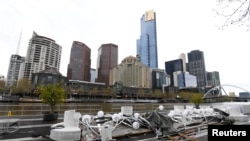Australia’s internal borders are to gradually reopen as COVID-19 infections continue to fall. South Australia and Queensland are easing restrictions with the neighboring state, New South Wales, for the first time in months. Australia has recorded about 27,000 coronavirus cases since the pandemic began, and more than 850 people have died.
South Australia has taken a very cautious approach to curbing the spread of the novel coronavirus. Most people are forbidden from entering the state from neighboring Victoria, which has had most of the nation’s coronavirus cases and fatalities. Those restrictions remain firmly in place, but starting Thursday, South Australia is reopening its border with New South Wales because that state has recorded no cases of community transmission of the virus for 14 days. Travelers will no longer have to go into quarantine.
South Australian Premier Steven Marshall says the eased restrictions will be a relief to residents.
“People from New South Wales wanting to come into South Australia from Thursday onwards will be able to do that without doing the 14-days of self-isolation. So, this will be a massive, massive relief to people who have been dislocated from friends, from family, from business opportunities. This will be a huge relief,” Marshall said.
From October 1, border restrictions between some northern districts in New South Wales and Queensland will be relaxed. The measures will allow more residents in border communities to travel freely between the two eastern states. However, the majority of people in New South Wales are still not allowed to travel to Queensland because of fears they could spread the virus.
People in Victoria cannot visit other Australian states and territories unless they hold an exemption, are an essential worker or live along a state border. The Victorian state government has said it was hopeful that falling infection rates will allow it to ease a strict lockdown measures in Melbourne.
Western Australia has no immediate plans to reopen to the rest of the country. Arrivals from other Australian jurisdictions must go into quarantine for 14 days before they are allowed to move freely about the state.
The federal government has long agitated for all internal borders to be reopened to help revive an economy that is in recession for the first time since 1991.
As parts of Australia begin to open up ahead of summer, the Northern Territory government is offering cash incentives to attract domestic tourists.
Australia is a country comprising six states, two principal mainland territories and a population of 25 million people.
Its international borders, which were closed to foreign nationals in March, are not expected to reopen until next year.




